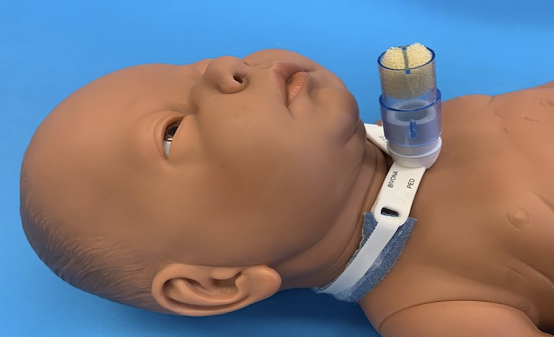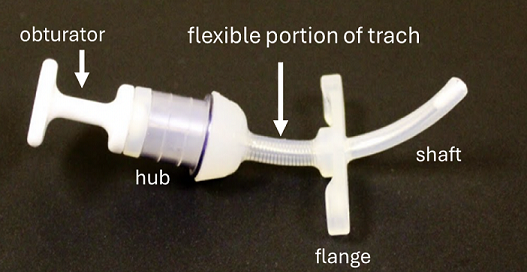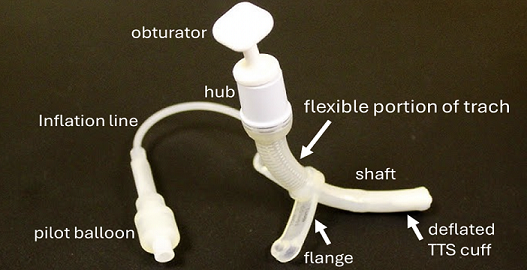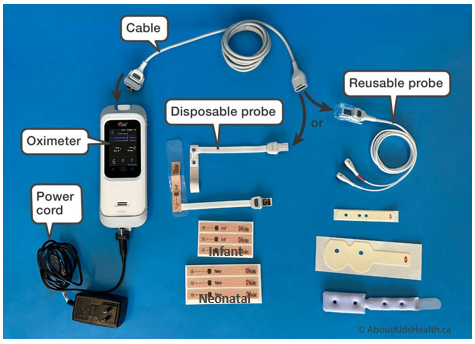HINT: What is a Bivona FlexTend tracheostomy tube and why is it used?
Connected Care Quick Hits are up to date and evidence based recommendations for the care of children with medical complexity & technology dependence, from hospital to home.
HINT: What is a Bivona FlexTend tracheostomy tube and why is it used?
SITUATION:
This QuickHit was developed in response to inquiries from home and community care providers regarding the use of Bivona FlexTend tracheostomy tubes for children in home and community.
BACKGROUND:
Bivona tracheostomy tubes are made from soft, flexible silicone, which is hydrophobic and hypoallergenic. This material helps prevent stoma irritation and promotes ease of cleaning the tracheostomy tube.
The FlexTend model features a flexible extension that connects directly to the neck flange, providing added distance between the tracheostomy tube and ventilator circuit. By keeping the tube connections away from the neck, chin, and stoma, this design reduces pressure points and improves patient comfort and mobility. These factors are especially important for paediatric patients and those positioned prone for respiratory or neurological management.
Example of an infant with a Bivona FlexTend cuffed TTS tracheostomy tube attached to the ventilator adaptor
Example of an infant with a Bivona cuffless FlexTend tracheostomy tube attached to a heat and moisture exchanger (HME)
Example of an infant with a regular flange Bivona cuffless tracheostomy tube attached to a heat and moisture exchanger (HME)
ASSESSMENT:
Bivona FlexTend tracheostomy tubes prevent mechanical irritation and pressure sores that are common with rigid tracheostomy tubes. Their flexibility allows safe positioning, enhancing comfort and movement while potentially lowering complications. Children with Bivona FlexTend tracheostomy tubes often include those needing prone positioning, children with larger or fuller necks that may obstruct the trach hub, or those who have had issues with traditional tubes. These tracheostomy tubes can be customized to meet individual patient needs and are available in cuffed (Tight-to-Shaft model or TTS) or uncuffed versions.
Bivona Uncuffed FlexTend
Bivona Cuffed Tight-to-Shaft (TTS) FlexTend
RECOMMENDATION:
Connected Care recommends the following considerations when caring for children with Bivona FlexTend tracheostomy tubes:
Ensure availability of both cuffed (TTS) and uncuffed tracheostomy models, and use the type prescribed by the child’s medical team.
At the beginning of each shift, verify the tracheostomy tube size and type as part of the safety check, ensuring it aligns with the child’s current medical orders. Customization options are available to meet individual patient needs, as determined by the child’s ENT specialist, and should be confirmed to support safe airway management.
Take safety precautions by being aware that the flexible design may make it easier for a child to pull on the tube, increasing the risk of dislodgement.
Clean the tracheostomy tube weekly or sooner if needed and replace it after 5 uses for neonatal and pediatric sizes or after 10 uses for adult and older sizes.
Be aware that although the FlexTend tube may be approved for use during Magnetic Resonance Imaging (MRI), it must be known to the health care team who may choose to replace with an alternate tube for better image quality
Please see the SickKids AboutKidsHealth Tracheostomy Care Manual for more on tracheostomy management.

















